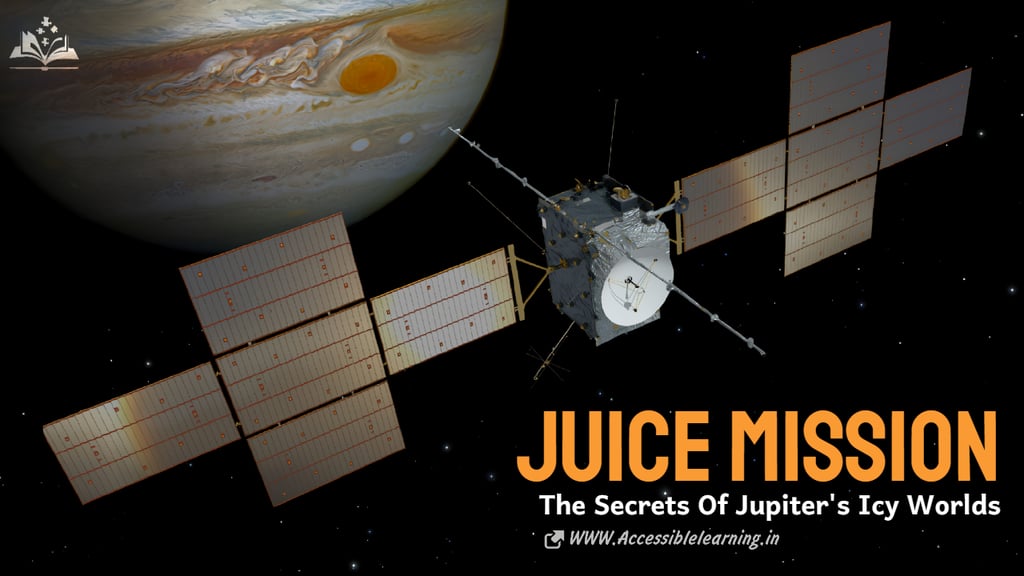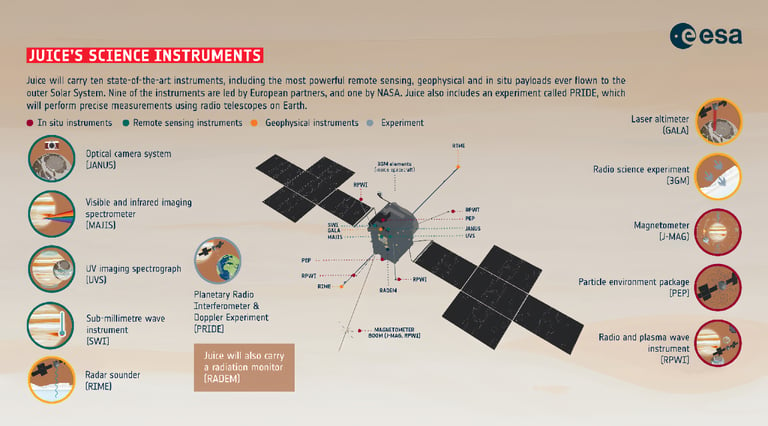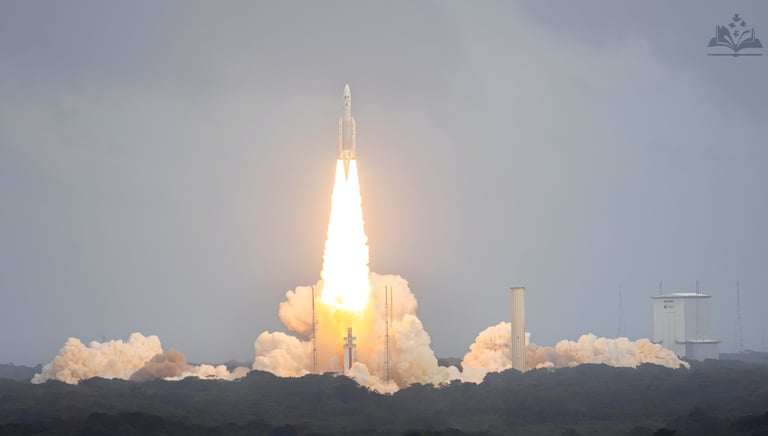
Jupiter Icy Moons Explorer (JUICE): The Secrets of Jupiter's Icy Worlds
Explore the European Space Agency's groundbreaking Jupiter Icy Moons Explorer (JUICE) mission, launched in April 2023. This comprehensive guide examines how this spacecraft will investigate Jupiter's potentially habitable icy moons, the advanced technology enabling this ambitious journey, and what scientists hope to discover about the possibility of life beyond Earth. Learn how JUICE builds on decades of outer solar system exploration while setting the stage for humanity's next great discoveries.
SPACE MISSIONISRO/NASAHARSH REALITYEDUCATION/KNOWLEDGESPACE/TECH
Sachin K Chaurasiya
3/28/202510 min read


The vast expanse of our solar system holds countless mysteries waiting to be discovered. Among the most intriguing are the icy moons orbiting Jupiter, which scientists believe may harbor the conditions necessary for life. To explore these fascinating worlds, the European Space Agency (ESA) has embarked on one of its most ambitious missions: the Jupiter Icy Moons Explorer, commonly known as JUICE.
The Mission That's Redefining Space Exploration
Launched on April 14, 2023, from French Guiana aboard an Ariane 5 rocket, JUICE represents a significant milestone in our quest to understand the outer solar system. The spacecraft began its extraordinary 8-year journey to Jupiter, traveling approximately 628 million kilometers to reach our solar system's largest planet.
JUICE isn't just another space mission. It's the largest spacecraft ever developed by ESA, weighing in at 6,000 kg at launch, including 2,000 kg of fuel. Its massive solar arrays, spanning 85 square meters, are designed to collect the faint sunlight at Jupiter's distance from the Sun—five times farther than Earth.
The mission cost approximately €1.6 billion ($1.8 billion), representing one of ESA's flagship "L-class" missions and highlighting Europe's commitment to planetary science and deep space exploration.
The Origins of JUICE
The concept for JUICE emerged from the ashes of an earlier, more ambitious mission. Initially, NASA and ESA had planned a joint venture called the Europa Jupiter System Mission-Laplace (EJSM-Laplace), which would have included two spacecraft—one from each agency—exploring different parts of the Jupiter system simultaneously.
However, budget constraints forced NASA to withdraw in 2011, prompting ESA to reshape the European component into a standalone mission. JUICE was officially selected as part of ESA's Cosmic Vision 2015-2025 program in May 2012, beating out competing proposals for X-ray and gravitational wave observatories.
The mission represents over a decade of planning, design, and construction, involving more than 83 companies from 16 different European countries and contributions from the United States, Japan, and Israel.
A Mission with Multiple Targets
Unlike previous missions to the Jupiter system, JUICE has set its sights on not just the gas giant itself but three of its largest moons: Ganymede, Callisto, and Europa. These icy worlds are suspected to harbor vast oceans beneath their frozen surfaces, making them prime candidates in our search for potentially habitable environments beyond Earth.
The mission's primary objectives include:
Investigating the potential for life in the Jupiter system
Exploring the conditions that might make Jupiter's moons habitable
Examining the complex dynamics between Jupiter and its diverse satellite system
Studying Ganymede as a planetary object and potential habitat
Analyzing the composition and structure of the icy crusts
Determining the depth, volume, and salinity of the subsurface oceans
Characterizing the magnetic fields and their interactions
Studying atmospheric composition and dynamics on Jupiter and its moons
State-of-the-Art Scientific Payload
To accomplish these ambitious goals, JUICE carries a suite of 10 state-of-the-art instruments:
JANUS (Jovis, Amorum ac Natorum Undique Scrutator): A camera system for high-resolution imaging capable of resolving features as small as 2.4 meters on Ganymede's surface
MAJIS (Moons and Jupiter Imaging Spectrometer): For analyzing surface composition through spectroscopy across visible and infrared wavelengths (0.4 to 5.7 µm)
UVS (UV Imaging Spectrograph): For ultraviolet observations of atmospheres and surfaces, detecting compounds like hydrogen, oxygen, and sulfur species
SWI (Sub-millimeter Wave Instrument): For studying atmospheric chemistry and temperature by observing submillimeter wavelength emissions
GALA (GAnymede Laser Altimeter): For mapping surface topography with precision down to a few meters
RIME (Radar for Icy Moons Exploration): For penetrating the icy crusts up to 9 km deep to study their structure and potential water reservoirs
J-MAG (JUICE Magnetometer): For analyzing magnetic fields with unprecedented sensitivity (0.1 nT)
PEP (Particle Environment Package): For studying plasma and particles, including a neutral gas and ion mass spectrometer
RPWI (Radio & Plasma Wave Investigation): For examining radio emissions and plasma environments using electric and magnetic field sensors
3GM (Gravity & Geophysics of Jupiter and Galilean Moons): For studying gravitational fields through radio science experiments that measure minute changes in the spacecraft's velocity
The instruments work together to provide complementary data, creating a comprehensive picture of the Jupiter system. For instance, while RIME probes beneath the surface, GALA maps the topography, and MAJIS determines the composition, giving scientists a multi-dimensional understanding of these fascinating worlds.
The Revolutionary Journey
JUICE's path to Jupiter is a testament to human ingenuity. The spacecraft is employing a complex series of gravity assists—flying close to Earth, Venus, and Earth again—to gain the momentum needed to reach Jupiter without consuming excessive fuel.
The trajectory includes:
First Earth flyby: August 2024
Venus flyby: August 2025
Second Earth flyby: September 2026
Third Earth-Moon system flyby: January 2029
Arrival at Jupiter: July 2031
This complex dance through the inner solar system will increase JUICE's velocity by effectively "stealing" tiny amounts of orbital energy from the planets it passes, demonstrating the elegance of celestial mechanics in space mission design.
After arriving at Jupiter in July 2031, JUICE will spend three and a half years conducting detailed observations of the gas giant and its moons. The mission includes:
2 flybys of Europa, approaching as close as 400 km to the surface
12 flybys of Callisto at various altitudes
21 flybys of Ganymede before entering orbit
The spacecraft will ultimately enter orbit around Ganymede in December 2034—becoming the first spacecraft ever to orbit a moon other than our own. JUICE will circle Ganymede at altitudes between 200 and 500 km, providing unprecedented detailed observations of this fascinating world.


Jupiter: The King of Planets
While JUICE's focus is primarily on Jupiter's moons, the mission will also study the gas giant itself in extraordinary detail. Jupiter, with its iconic Great Red Spot and complex band structures, represents a class of planets now known to be common throughout our galaxy.
JUICE will investigate:
The structure and dynamics of Jupiter's turbulent atmosphere
The planet's powerful magnetosphere, the largest magnetic structure in our solar system
The intricate interactions between Jupiter and its moons, including plasma and radiation environments
The planet's interior structure through gravity measurements
Understanding Jupiter is crucial not only for comprehending our own solar system but also for interpreting observations of the thousands of Jupiter-like exoplanets discovered around other stars.
Callisto: Window to the Past
While Ganymede often receives the most attention, Callisto—Jupiter's second-largest moon—offers unique scientific opportunities. As the most heavily cratered object in the solar system, Callisto serves as a time capsule, preserving a record of the early solar system bombardment history.
Unlike the other Galilean moons, Callisto appears to be only partially differentiated, meaning its interior isn't fully separated into distinct layers. This suggests the moon never became hot enough for complete differentiation, providing insights into the thermal history of the Jupiter system.
JUICE will investigate:
The composition of Callisto's ancient, dark surface
Evidence for a subsurface ocean approximately 250 km below the icy crust
The moon's thin carbon dioxide atmosphere
Signs of past geological activity
Europa: Potentially the Most Habitable
Though JUICE will make only two flybys of Europa, these encounters will complement NASA's Europa Clipper mission (scheduled to arrive at Jupiter in 2030) by providing different viewing angles and observations at different times.
Europa is of particular interest because:
Its subsurface ocean is believed to be in direct contact with a rocky seafloor, allowing for the exchange of minerals and potential chemical energy sources
Its relatively thin ice shell (estimated at 15–25 km) may allow for interactions between the surface and ocean
Active plumes of water vapor have been detected erupting from the surface, potentially providing direct samples of the subsurface ocean
Its young surface (40–90 million years) indicates recent and possibly ongoing geological activity
JUICE's Europa flybys will focus on regions not covered by previous missions or planned for study by Europa Clipper, maximizing the scientific return from both missions.
Ganymede: A World of Wonders
Ganymede, JUICE's ultimate destination, is a fascinating world in its own right. As the largest moon in our solar system—even larger than the planet Mercury—Ganymede boasts several unique features:
The only moon known to generate its own magnetic field, with a strength about 1% of Earth's
A differentiated internal structure with a metallic core, silicate mantle, and icy crust
Evidence of a subsurface ocean containing more water than all of Earth's oceans combined
A thin atmosphere containing oxygen, hydrogen, and ozone
Complex terrain including grooved features, suggesting a rich geological history
Polar regions that may contain preserved organic compounds
More details about Ganymede's structure include:
A suspected iron-sulfur core approximately 500 km in radius
A silicate mantle extending about 950 km beyond the core
A 500 km thick ice layer with multiple distinct ice phases due to pressure
A global saltwater ocean approximately 100 km thick
An outer ice crust 150 km thick
By studying Ganymede in unprecedented detail, scientists hope to gain insights into how moons form and evolve around gas giants and whether such worlds could potentially support life.
Technological Marvels and Challenges
Designing a spacecraft for the harsh environment of Jupiter presented numerous engineering challenges. Jupiter's intense radiation belts can damage sensitive electronics, while the great distance from the Sun means solar power is limited.
To overcome these obstacles, JUICE incorporates:
Radiation-hardened components and shielding equivalent to 250 mm of aluminum to protect its instruments
Highly efficient solar panels specially designed for low-light conditions, capable of generating 850 watts at Jupiter despite receiving only 3.7% of the sunlight available at Earth
Autonomous navigation and fault-detection systems capable of operating with minimal ground intervention
Advanced thermal management to handle temperature extremes from +250°C in Venus flybys to -230°C in Jupiter's shadow
A propulsion system with 400 kg of fuel capacity for a total delta-V of 2 km/s
A high-gain antenna 2.5 meters in diameter for communicating with Earth at distances of up to 900 million kilometers
Specially designed star trackers that can function despite Jupiter's bright presence
Titanium structures designed to withstand the immense stresses of launch and multiple gravity assists
The spacecraft's expected operational lifetime is approximately 11 years, though mission planners hope it may exceed this estimate as many spacecraft have done before.


The Search for Life's Potential
Perhaps the most compelling aspect of the JUICE mission is its connection to astrobiology—the search for life beyond Earth. The icy moons of Jupiter are considered some of the most promising places in our solar system to look for environments that could support life.
The subsurface oceans of these moons are thought to be in contact with rocks, creating potential for the chemical reactions necessary for life. Moreover, tidal heating from Jupiter's gravitational pull provides energy that could sustain such reactions.
Specific considerations for habitability include:
Chemical energy sources from water-rock interactions at the ocean floor
Potential hydrothermal vents similar to those that support life in Earth's deep oceans
Protection from radiation provided by the thick ice crusts
Stable conditions maintained over billions of years
Essential elements (carbon, hydrogen, nitrogen, oxygen, phosphorus, sulfur) likely present in the ocean
While JUICE isn't designed to directly detect life, it will gather crucial data about the conditions on these moons, helping scientists determine whether they meet the basic requirements for habitability.
International Collaboration
JUICE exemplifies international scientific cooperation. While led by ESA, the mission involves contributions from space agencies and institutions across the globe, including NASA, JAXA (Japan Aerospace Exploration Agency), and various European national space agencies.
More than 15 countries participated in building the spacecraft and its instruments, demonstrating how space exploration transcends national boundaries and unites humanity in our quest for knowledge.
The mission's prime contractor was Airbus Defence and Space, which oversaw a consortium of over 83 companies across Europe. The scientific payload includes instruments from teams in Italy, France, Germany, Sweden, the UK, and the United States, each bringing specialized expertise to the mission.
Historical Context: Building on Past Jupiter Missions
JUICE builds upon the legacy of previous missions to the Jupiter system, including:
Pioneer 10 and 11 (1973-1974): The first spacecraft to travel through the asteroid belt and visit Jupiter, providing our first close-up images
Voyager 1 and 2 (1979): Transformed our understanding of Jupiter and discovered volcanic activity on Io, among numerous other findings
Galileo (1995-2003): The first spacecraft to orbit Jupiter, conducted detailed studies of the Galilean moons and dropped a probe into Jupiter's atmosphere
Cassini (2000): Made observations of Jupiter during its flyby en route to Saturn
New Horizons (2007): Studied Jupiter during a gravity assist on its way to Pluto
Juno (2016-present): Currently orbiting Jupiter, focusing on the planet's interior structure, atmosphere, and magnetosphere
Each mission has built upon the discoveries of its predecessors, gradually unveiling the complexity of the Jupiter system. JUICE represents the next chapter in this scientific story, focusing specifically on the icy moons that previous missions could only study briefly or from a distance.
The Legacy of JUICE
Looking beyond the immediate scientific returns, JUICE will leave an enduring legacy. The mission will:
Provide a comprehensive understanding of the Jupiter system as a model for gas giants across the universe
Advance our knowledge of potentially habitable environments in our solar system
Test technologies that will enable future exploration of the outer solar system
Inspire the next generation of scientists and engineers
Lay the groundwork for possible future missions to land on these intriguing moons
Contribute to our understanding of how planetary systems form and evolve
Help astronomers interpret observations of exoplanetary systems
Potentially reshape our understanding of where life might exist in the universe


Future Missions: Beyond JUICE
JUICE is part of a broader strategy for exploring the outer solar system. NASA's Europa Clipper mission, scheduled to launch in October 2024, will complement JUICE by focusing intensively on Europa.
Looking further ahead, scientists have proposed several follow-up missions, including:
A lander for Ganymede or Europa to directly sample the surface
A penetrator or cryobot that could melt through the ice crust to access the subsurface ocean
A network of small probes to monitor seismic activity and other environmental parameters
Sample return missions that could bring material back to Earth for detailed analysis
Each of these concepts presents significant technological challenges but would provide data impossible to obtain through remote sensing alone. The discoveries made by JUICE will help inform which of these mission concepts should be prioritized.
Public Engagement and Citizen Science
Beyond its scientific goals, JUICE aims to engage the public in space exploration. The mission includes several public outreach initiatives:
A "Send Your Name to Jupiter" campaign that allowed members of the public to have their names encoded on a microchip aboard the spacecraft
Open data policies that will make the mission's scientific findings accessible to researchers worldwide
Educational resources for schools to incorporate JUICE's discoveries into science curricula
Opportunities for amateur astronomers to contribute observations of Jupiter and its moons
Regular updates and images shared through social media and other public platforms
As JUICE makes its way toward Jupiter, it carries with it humanity's curiosity and our unending desire to understand our place in the cosmos. By exploring the potential for life on Jupiter's icy moons, we gain perspective on our own home planet and the possibility that Earth may not be the only abode for life in our solar system.
The data collected by JUICE will keep scientists busy for decades, potentially reshaping our understanding of planetary formation, evolution, and the conditions that make a world habitable. As we follow this ambitious mission from Earth, we participate in a journey that expands not just our knowledge of distant worlds but our appreciation for the remarkable universe we inhabit.
The exploration of Jupiter's icy moons is not just about discovering what lies beneath their frozen surfaces—it's about uncovering the potential for life beyond our home planet and understanding our own origins in the greater cosmic context. In this sense, JUICE represents one of humanity's most profound quests: the search for life's potential beyond the confines of our own world.
Subscribe To Our Newsletter
All © Copyright reserved by Accessible-Learning Hub
| Terms & Conditions
Knowledge is power. Learn with Us. 📚


